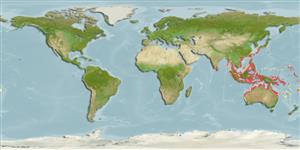>
Ovalentaria/misc (Various families in series Ovalentaria) >
Pomacentridae (Damselfishes) > Pomacentrinae
Etymology: Neopomacentrus: Greek, neos = new + Greek,poma = cover, operculum + Greek,kentron = sting (Ref. 45335).
Eponymy: Robert Austin Bautues Bankier (1815–1853) was a naturalist and Royal Naval surgeon on HMS Blenheim (1842) and was Surgeon-in-Charge HMS Alligator and later HMS Minden, both of which were hospital ships. [...] (Ref. 128868), visit book page.
More on author: Richardson.
Environment: milieu / climate zone / depth range / distribution range
Ökologie
seewasser riff-verbunden; standorttreu; tiefenbereich 3 - 12 m (Ref. 7247). Tropical
Western Pacific: there are two separate populations but further collections may provide evidence for a continuous distribution. The first population inhabits the South China and Java seas. The second population is known from eastern Queensland and the vicinity of Daru Island off southern Papua New Guinea.
Size / Gewicht / Alter
Maturity: Lm ? range ? - ? cm
Max length : 8.0 cm TL Männchen/unbestimmt; (Ref. 9710)
Rückenflossenstacheln (insgesamt) : 13; Rückenflossenweichstrahlen (insgesamt) : 11; Afterflossenstacheln: 2; Afterflossenweichstrahlen: 11 - 12.
Adults inhabit coastal reefs around coral or rock outcrops on soft bottoms (Ref. 9710). Oviparous, distinct pairing during breeding (Ref. 205). Eggs are demersal and adhere to the substrate (Ref. 205). Males guard and aerate the eggs (Ref. 205). Have been reared in captivity (Ref. 35404). Diurnal species (Ref. 113699).
Life cycle and mating behavior
Geschlechtsreife | Fortpflanzung | Ablaichen | Eier | Fecundity | Larven
Oviparous, distinct pairing during breeding (Ref. 205). Eggs are demersal and adhere to the substrate (Ref. 205). Males guard and aerate the eggs (Ref. 205).
Allen, G.R., 1991. Damselfishes of the world. Mergus Publishers, Melle, Germany. 271 p. (Ref. 7247)
IUCN Rote Liste Status (Ref. 130435: Version 2024-1)
Bedrohung für Menschen
Harmless
Nutzung durch Menschen
Tools
Zusatzinformationen
Download XML
Internet Quellen
Estimates based on models
Preferred temperature (Ref.
123201): 24.9 - 29.3, mean 28.6 °C (based on 2366 cells).
Phylogenetic diversity index (Ref.
82804): PD
50 = 0.5000 [Uniqueness, from 0.5 = low to 2.0 = high].
Bayesian length-weight: a=0.01479 (0.00651 - 0.03363), b=3.00 (2.81 - 3.19), in cm total length, based on LWR estimates for this (Sub)family-body shape (Ref.
93245).
Trophic level (Ref.
69278): 3.4 ±0.4 se; based on size and trophs of closest relatives
Widerstandsfähigkeit (Ref.
120179): hoch, Verdopplung der Population dauert weniger als 15 Monate. (Preliminary K or Fecundity.).
Fishing Vulnerability (Ref.
59153): Low vulnerability (10 of 100).
Nutrients (Ref.
124155): Calcium = 151 [87, 298] mg/100g; Iron = 1.06 [0.63, 1.76] mg/100g; Protein = 18.4 [17.3, 19.5] %; Omega3 = 0.139 [0.079, 0.248] g/100g; Selenium = 18.4 [9.7, 37.3] μg/100g; VitaminA = 222 [70, 697] μg/100g; Zinc = 2.27 [1.51, 3.26] mg/100g (wet weight);
